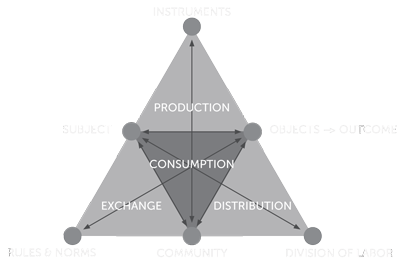Activity Theory
Activity Theory was introduced to the world in 1920 with Vygotsky’s “cultural-historical tradition,” ever since many have tried to explore it. 
Aleksei Leontiev’s work, Activity, Consciousness, and Personality (1978) is the most well defined explanation of activity theory and was the main inspiration of the third chapter in Victor Kaptelinin and Bonnie Nardi’s book, Acting with technology: Activity theory and interaction design. In this book they describe about the key concepts, ideas, principles, history of activity theory and its application to the analysis and design of technologies or interaction design. They say that, “Activity is considered the most basic category; analysis of activities opens up a possibility to properly understand both subjects and objects.”
According to Kaptelinin and Nardi, activity theory is an approach that tries to understand the “individual human beings, as well as the social entities they compose, in their natural everyday life circumstances, through an analysis of the genesis, structure, and process of their activities.” This related to other theories like, Situated Action, and Distributed Cognition. Both these theories to an extent suggest that we have to first understand the surroundings of the human beings/subjects and their actions in context with their surroundings before we focus on the objects or technologies with which they interact.
According to scholars related to activity theory, there are a few basic principles that construct activity theory:
1. Object-Orientedness: Most of human activity is focused towards obtaining certain objects that are defined socially. And since people’s needs and goals change over time so does the activity related to those goals. Therefore activity is in a way object-oriented.
2. Hierarchy/Structure of Activity: There are three levels of activity: Activities, actions (specific goal-directed processes) and operations (automated actions) and these are very dynamic in nature and change according to the activity that the subject is performing.
3. Internalization and Externalization: The four main aspects of internalization and externalization are mental processes vs external behavior and interpsychological vs intrapsychological. The cognitive processes of the subject are the internal activities. And when subjects seek the help of external factors to complete their activities, it is called as externalization. Activity Theory “…emphasizes that it is the constant transformation between the external and the internal that is the basis of human activity.” When learning something new, their activity in more external and once they become proficient, the activity becomes internalization or transforms into an internal cognitive process. When an activity is distributed between the learner and an external subject it becomes interpsychological or a socially distributed activity. And as one becomes experienced in that activity, it can become more of an intrapsychological function.
4. Mediation: Subjects use several tools, elements and technologies to achieve their tasks or perform their activities. These represent their cultural or historical factors that cater to the way people act in their societies.
5. Development: The key research method explaining this is the formative experiment that monitors the developmental changes overtime. There is a constant change in relationship between the subject and object and the activities related to them. Therefore it is very much necessary that we focus on the development of an activity.
Activity Theory Pioneers and Scholars
- Yrgö Engeström, professor of education and communication at the University of Helsinki is noted for Activity Theory and Theory of Expansive Learning.
- Susanne Bødker, professor of HCI at the University of Aarhus in Denmark is noted for Activity Theory.
- Lucy Suchman, professor of anthropology at Lancaster University, UK, is noted for developing the Theory of Situated Cognition, and early contributions to Activity Theory.
Text by Divya Addepalli and Susan Oldham, image by Susan Oldham.